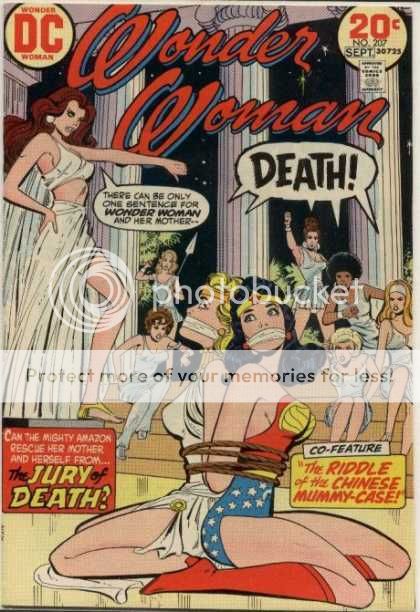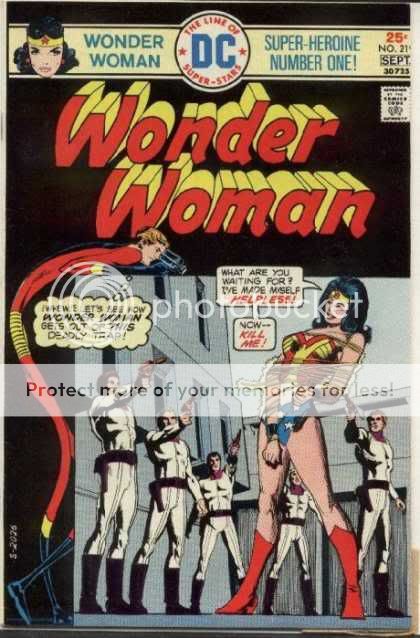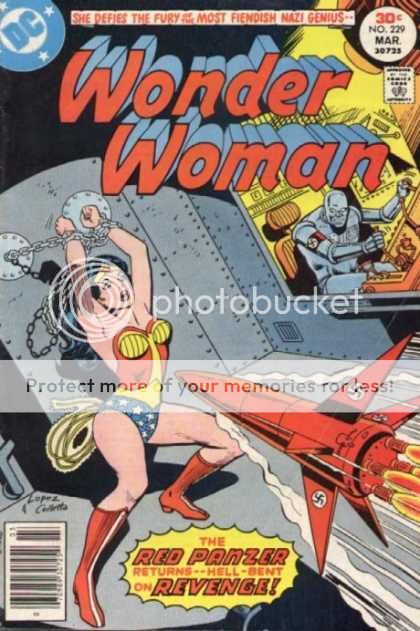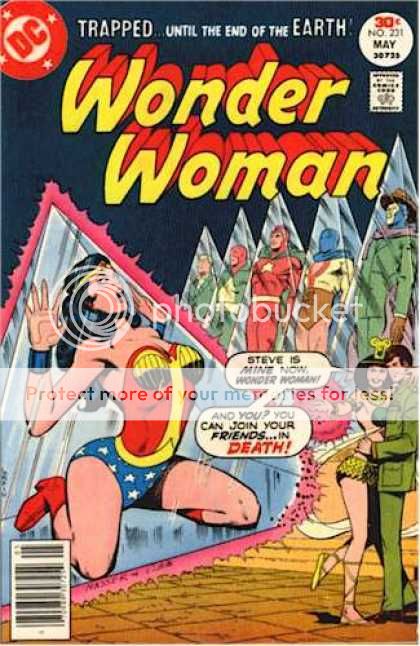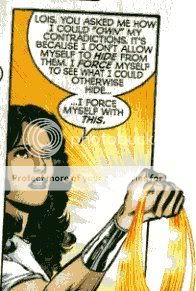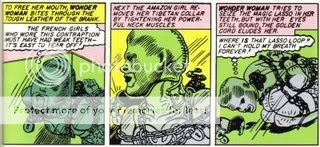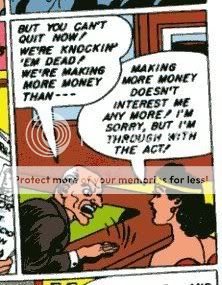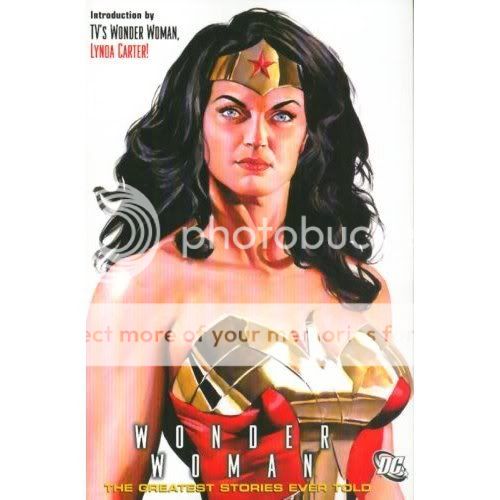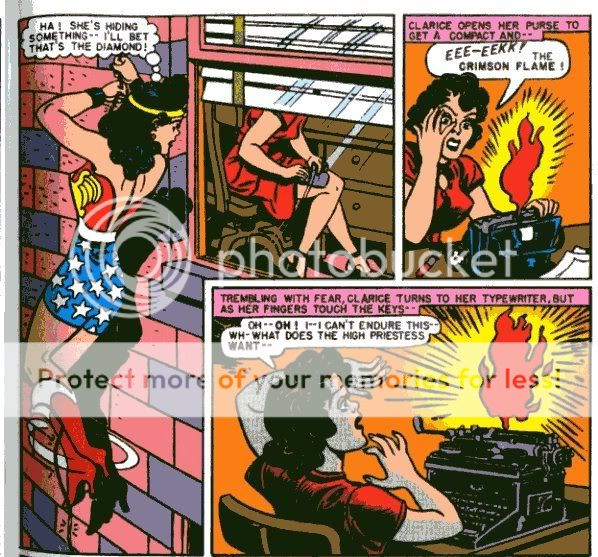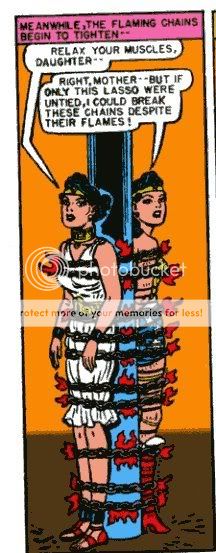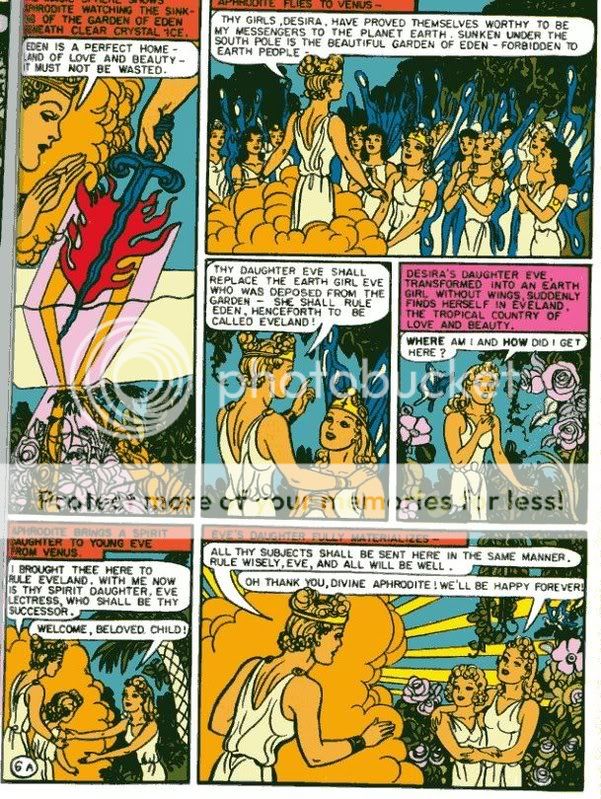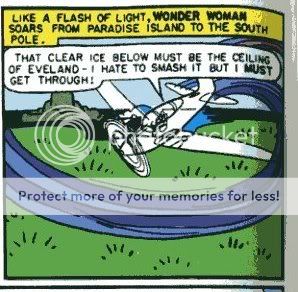So this is my second longish post on Wonder Woman. In the last one I talked about Charles Moulton, Wonder Womans’ creator, and why I thought it was very difficult for other writers to put together decent stories using his character. Basically, I argued that whereas Superman, Batman, Spider-man, etc., are to some extent just interchangeable adventure heroes, Wonder Woman stories were much more like something by Tom Of Finland or R. Crumb — that is, Moulton had an idiosyncratic vision based on his (fairly explicit) sexual kinks (basically strong woman, bondage, control, submission — that kind of thing.) Again, you might want to read the whole thing here if you haven’t.
All right. So I was going to look now at why or in what ways Wonder Woman has been a problem for the writers who have come after Moulton.
Basically, Moulton’s Wonder Woman is (ahem) bound up with his a very particular set of fetishes and fantasies. Moulton made his stories about those fetishes and fantasies; that’s what he wanted to talk about, and in that context WW’s appearance (girly, uncovered) her tools (the magic lasso, the bracelets) and her contradictory image (powerful, but always being dominated) all make at least a kind of sense. His weird blend of feminism/misogyny (“I love strong women — tie them up so I may love them more!”) which means you can’t get the feminism without the misogyny, but also means you can’t get the misogyny without the feminism. In particular, the way and the extent to which Moulton presents and fetishizes female relationships seems equally tied up with his own sexual peccadillos (lesbianism is never very far below the surface here) and with ideas about girls supporting each other in a feminist or protofeminist way. Certainly, Moulton comics are far, far from the first thing I’d give to my daughter, but I can see why young girls might have found something to connect with in them. Women have power (they are so, so powerful!) and they love each other (oh, please, love each other more!)
I guess the point I’m making is that there’s misogyny, but it’s not gratuitous. Moulton has a vision. It’s not PC and it’s totally sexually twisted, but at least he’s thought about it. He cares about women. You can mock that, or argue with that, or even suggest that it might be better for everyone if he cared about women a little less, but at least there’s the sense that he’s paying attention. This is someone in particular’s misogyny –which means it’s also someone in particular’s feminism. He’s not trying to sell you a bill of goods and then backhanding you. The whole thing is up front. To me, that just seems less oppressive, in various senses.
When other folks use Wonder Woman, though…well, things don’t work quite as well. The fetishization and bondage weirdness are at least somewhat disavowed…but you don’t get rid of them that easily.
Disempowerment in various forms is a staple of super-hero covers. For men, though, it usually involves bodily transformation (Flash’s big head) or humiliations in which the sexual implications are at least a bit more repressed. But here…Wonder Woman tied up and smiling as she playfully cocks her crotch and begs for it with the (ahem) Elongated Man looking on eagerly; Wonder Woman tied up and legs spread with a missile propitiously aimed; kneeling with legs spread…I mean, it’s not especially subtle, is it?
Again, the point here is that this isn’t a perversion of the character — this is the character. But still, something has definitely gone wrong. Part of the problem is the art; after the Moulton era, WW moved towards the standard semi-realistic super-hero art meme. The result is that what is a kind of iconic fantasy in Peter’s work ends up looking a lot more like basic cheesecake illustration. Or, to put it another way, it becomes more generic, less about whatever cathexis of strength/dominance/idealism/smuttiness went into Moulton’s Wonder Woman, and more about whatever expected thing guys want to look at. As a result, these covers don’t seem odd or bizarre, the way Moulton’s work did. They seem predictable. Wonder Woman was always wank fodder, I think, but here she ends up as just wank fodder. There’s nothing else going on. We’ve gone from someone’s particular hothouse boudoir to a generalized locker-room for geekish fanboys.
As witness the unfortunately named 1959 gem “Wanted — Wonder Woman” by Robert Kanigher and Ross Andru (reprinted in Greatest WW stories ever told). The story features a race of short, unusually ugly multi-limbed green aliens, who control Diana’s mind and force her to agree to marry Steve Trevor.
Can I just say…ewwww. The little aliens all jubilant together because they’ve romantically-sexually manipulated the heroine; it’s like a bunch of thirteen-year-old-boys celebrating after stealing their Mom’s friend’s panties — or like a bunch of comics geeks chortling to themselves about the off-color WW fan-fic they just wrote. It’s comic creator as pre-adolescent tyrant, guiltily manipulaiting his little plastic toy (and in Ross Andru’s art, all the characters do indeed look plastic.) The whole thing is just smarmy and repressed and depressing. Compared to this, good honest bondage — or good honest parasite fetishism, if that’s the way Kanigher swings — would seem positively healthy.
As usual, Grant Morrison channels the zeitgeist most effectively:
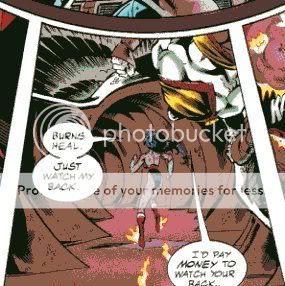
©Grant Morrison and Howard Porter, aka, the worst artist in the world.
Wonder Woman: she’s a super-hero…and a victim of sexual harassment! Who says you can’t have it all, ladies! (That’s a real honest to goodness angel with the smarmy patter there, too. Now you know…there are frat boys in heaven.)
Admittedly, not all Wonder Woman writers have necessarily gone for cheap titillation and demeaning, half-disavowed power fantasies. If they don’t take Moulton to the most obvious stupid place, though, he often ends up ambushing them. Here’s a memorable panel:
This is from an old 70s Super-Friends comic. As the caption says, Wonder Woman has been forced to discard her bracelets for various reasons. And, as a result, she turns into a beserker, because Amazons need metal bracelets to restrain them. It’s a total Charles Moulton plot device — bondage, restraint, blah, blah. But nothing else in the Super-friends has anything to do with these themes. Wonder Woman herself is completely bland; like all the other super-friends, she talks and acts like a boy scout crossed with Calvin Coolidge and a primary school teacher. Then, all of a sudden, she’s some sort of primal deadly female force who threatens us all! You’ve got this basic boring kids comic, and suddenly comics’ horny atavistic past rears up (in various senses) and your tots are looking at Charles Moulton’s fetish problems. This is certainly bizarre — but it still isn’t exactly individualistic. It just feels like nobody’s at the tiller; the misogyny is just a flat accident, it’s an ignorant flub, attributable equally to (A) the creator’s lack of interest in Wonder Woman and (B) the creator’s lack of interest in woman. Thus, while the moment does have an aphasiac charm, it’s also undeniably a parodically casual desecration. Superman, Batman, Aquaman, Green Arrow, even Spider-Man; none of them were really meant to say anything in particular. But Wonder Woman was; Moulton intended to use her to embody his own ideas (however cracked) about feminism and femininity. His successors overwhelmingly didn’t give a shit.
One last story: this one by Phil Jimenez. Called “She’s a Wonder,” it’s from 2001, and was reprinted in the Greatest WW stories ever told volume, The narrative’s about Lois Lane writing a puff piece about Wonder Woman. In some ways, it’s really not bad. Jimenez is a talented draftsman; following in George Perez’s footsteps, his Wonder Woman actually looks Greek, for example, and he obviously has a lot of fun drawing her in different costumes. He also has a nice way with (often bitchy) dialogue, and as a result the very talky script doesn’t seem burdensome. We see WW talking to President Luthor (“more full of dung than the Augean stables”), getting rejected by a hot humanitarian do-gooder (“isn’t he beautiful?”) chatting with some flaming friends (“you think all men are gay!” “well they are — especially the men.”) It’s actually a lot like reading an actual puff piece — a good one. Diana comes across as beautiful, likable, smart, dedicated — sort of a hyped-up Angelina Jolie, down to the Third-World charity work. The whole story is obviously fairly idiotic in some sense — why do we want to read celebrity journalism about a fictional character again? But it’s done with enough humor and grace that it’s hard to feel sour about it.
Until right at the end. Lois, who’s somewhat resentful of Diana’s relationship with Superman, demands to know how Wonder Woman does it all — how she can be the modern woman — so strong and yet so feminine — how she can fight bad guys all day but still smell morning fresh — how she can “accept her contradictions.” It’s a pretty dumb thing to ask, but the answer is even dumber — WW proudly sticks out her magic bondage lasso of truth, and explains that it’s what keeps her honest. She is all the woman she can be because she ties herself up every night before she goes to bed.
Charles Moulton would be proud, presumably. But is that really what Jimenez wanted to say? He started out trying to tell a story about a complex woman for the oughts, and he ends up saying the road to feminist paradise is through New Age B&D? The puff piece just kind of deflates with a giant “frrraaaaappppppppp.” Poor Jimenez. Unlike most of his peers, he obviously does care about this character, but…well, what can you do? Dress her up, make her talk like a human being, give her nice clothes and tell her you really admire her for her mind; it doesn’t matter. Wonder Woman’s still going to be true to the weirdo who brung her. Moulton’s still her man.
Update: And Part 3 now up. Also, part 4.
Update 2: And part 5.

